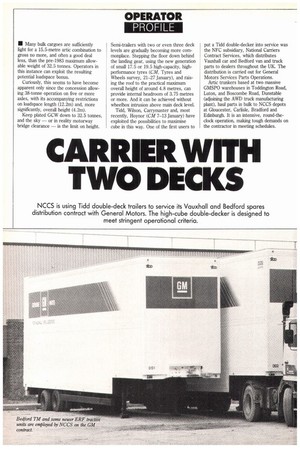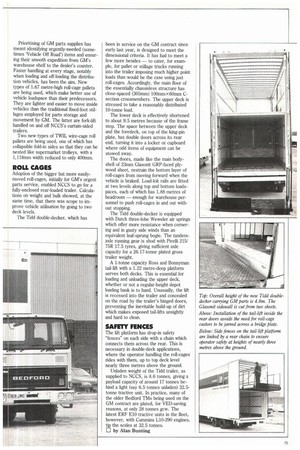CARRIER WITH TWO DECKS
Page 76

Page 77

If you've noticed an error in this article please click here to report it so we can fix it.
• Many bulk cargoes are sufficiently light for a 15.5-metre a,rtic combination to gross no more, and often a good deal less, than the pre-1983 maximum allowable weight of 32.5 tonnes. Operators in this instance can exploit the resulting potential loadspace bonus.
Curiously, this seems to have become apparent only since the concession allowing 38-tonne operation on five or more axles, with its accompanying restrictions on loadspace length (12.2m) and, more significantly, overall height (4.2m).
Keep plated GCW down to 32.5 tonnes, and the sky — or in reality motorway bridge clearance is the limit on height. Semi-trailers with two or even three deck levels are gradually becoming more commonplace. Stepping the floor down behind the landing gear, using the new generation of small 17.5 or 19.5 high-capacity, highperformance tyres (CM, Tyres and Wheels survey, 21-27 January), and raising the roof to the practical maximum overall height of around 4.8 metres, can provide internal headroom of 3.75 metres or more. And it can be achieved without wheelbox intrusion above main deck level.
Tidd, Wilson, Carrymaster and, most recently, Hoynor (CM 7-13 January) have exploited the possibilities to maximise cube in this way. One of the first users to put a Tidd double-decker into service was the NFC subsidiary, National Carriers Contract Services, which distributes Vauxhall car and Bedford van and truck parts to dealers throughout the UK. The distribution is carried out for General Motors Services Parts Operations.
Artic trunkers based at two massive GMSPO warehouses in Toddington Road, Luton, and Boscombe Road, Dunstable (adjoining the AWD truck manufacturing plant), haul parts in bulk to NCCS depots at Gloucester, Carlisle, Bradford and Edinburgh. It is an intensive, round-theclock operation, making tough demands on the contractor in meeting schedules. Prioritising of GM parts supplies has meant identifying urgently-needed (sometimes 'Vehicle Off Road') items and ensuring their smooth expedition from GM's warehouse shelf to the dealer's counter. Faster handling at every stage, notably when loading and off-loading the distribution vehicles, has been the aim. New types of 1.67 metre-high roll-cage pallets are being used, which make better use of vehicle loadspace than their predecessors. They are lighter and easier to move inside vehicles than the traditional fixed-foot stillages employed for parts storage and movement by GM. The latter are fork-Lift handled on and off NCCS's curtain-sided trailers.
Two new types of TWIL wire-cage roll pallets are being used, one of which has collapsible fold-in sides so that they can be nested like supermarket trolleys, with a 1,118nuu width reduced to only 400mm.
ROLL CAGES
Adoption of the bigger but more easilymoved roll-cages, initially for GM's urgent parts service, enabled NCCS to go for a fully-enclosed rear-loaded trailer. Calculations on weight and bulk showed, at the same time, that there was scope to improve vehicle utilisation by going to two deck levels.
The Tidd double-decker, which has
been in service on the GM contract since early last year, is designed to meet the dimensional criteria. It has had to meet a few more besides — to cater, for example, for pallet or stillage trucks running into the trailer imposing much higher point loads than would be the case using just roil-cages. Accordingly, the main floor of the essentially chassisless structure has close-spaced (305mm) 100mm x6Omm Csection crossmembers. The upper deck is stressed to take a reasonably distributed 10-tonne load.
The lower deck is effectively shortened to about 9.5 metres because of the frame step. The space between the upper deck and the foredeck, on top of the king-pin plate, has double doors across its rear end, turning it into a locker or cupboard where odd items of equipment can be stowed away.
The doors, made like the main bodyshell of 23nun Glasonit GRP-faced plywood sheet, restrain the bottom layer of roll-cages from moving forward when the vehicle is braked. Load-lok rails are fitted at two levels along top and bottom loadspaces, each of which has 1.88 metres of headroom — enough for warehouse personnel to push roll-cages in and out without stopping.
The Tidd double-decker is equipped with Dutch three-lobe Weweler air springs which offer more resistance when cornering and in gusty side winds than an equivalent leaf-sprung bogie. The tandemaxle running gear is shod with Pirelli 215/ 75R 17.5 tyres, giving sufficient axle capacity for a 26.17-tonne plated gross trailer weight.
A 1-tonne capacity Ross and Bonnyman tail-lift with a 1.22 metre-deep platform serves both decks. This is essential for loading and unloading the upper deck, whether or not a regular-height depot loading bank is to hand. Unusually, the lift is recessed into the trailer and concealed on the road by the trailer's hinged doors, preventing the inevitable build-up of dirt which makes exposed tail-lifts unsightly and hard to clean.
SAFETY FENCES
The aft platform has drop-in safety "fences" on each side with a chain which connects them across the rear. This is necessary in double-deck applications, where the operator handling the roll-cages rides with them, up to top deck level nearly three metres above the ground.
Unladen weight of the Tidd trailer, as supplied to NCCS, is 8.6 tonnes, giving a payload capacity of around 17 tonnes behind a light (say 6.5 tonnes unladen) 32.5tonne tractive unit. In practice, many of the older Bedford TMs being used on the GM contract are plated, for VED-saving reasons, at only 28 tonnes gcw. The latest ERF EIO tractive units in the fleet, however, with Cummins L10-290 engines, tip the scales at 32.5 tonnes.
ill by Alan Bunting




















































































































































